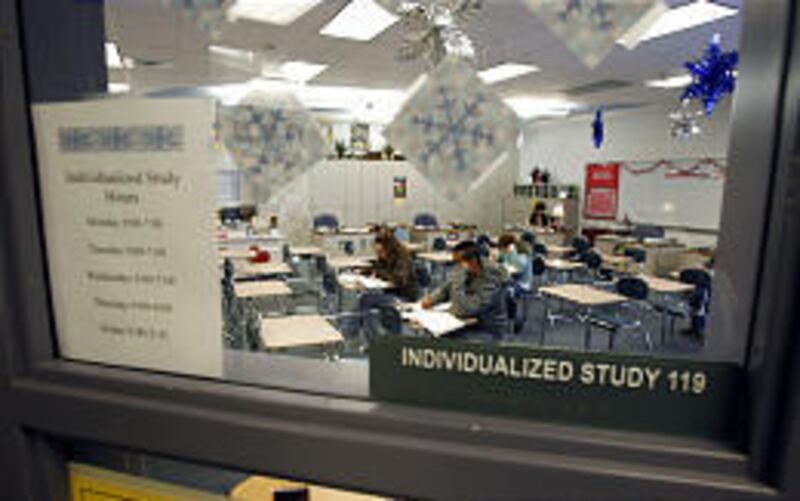It's no longer grabbing many headlines, but the question remains: Precisely what is Granite High School?
In late 2005, the Granite Board of Education voted, as it closed two elementary schools, to make the district's aging, flagship school an "umbrella" institution with no boundaries or competitive athletics.
Under the umbrella are Central High, the alternative school down the street, and the Young Parent Program in West Valley City. It also was envisioned that Granite's longtime South Salt Lake campus would continue a regular academic program, plus offer performing arts and career academies and a "newcomers" program to help immigrant students get on their feet.
But that vision still evolves, particularly within the Granite High building. While the Newcomers program thrives, there are no academies, and one entire school wing, and some classrooms in the main building, are vacant. Programmatic changes at Central High have rankled students and faculty. The Young Parent Program's leader praises improvements at its campus but says it has run out of room. Twenty teen moms remain on a waiting list.
Granite High art, student government and career and technical education teacher Stan Maeser sums up his experience: "We're in limbo."
"It's really hard to define what this is," said Maeser, a Granite High alumnus who has taught at the school several years. "I want to stay here if it's going to turn into something. But I don't want to ... watch it die."
The Granite Board of Education on Tuesday will study where the Granite umbrella has come since its fall debut.
But how the board might move to weave these three distinct programs together, if at all, is anyone's guess.
The Central High campus — now dubbed Granite High Alternative School — is abuzz with change and angst.
Students have a new dress code. The drop-system, where students are removed from a class if they have too many absences, was replaced with a competency-based system. The school now stresses core curriculum, eliminating some of the quirky kinds of classes intended to draw in its unique student body.
Several faculty and students haven't taken too kindly to the changes. While some teachers praise replacing the drop-system with competency, things like axing Halloween dress-up and not letting students wear slippers to class don't work here, they say.
"Our goal is to give kids another chance in a less structured environment," science and driver's ed teacher Robert Spencer said.
As another teacher puts it, who cares whether the students are in slippers if they're in class?
A philosophical clash of sorts has ensued.
Faculty members, citing low morale, last month sent a no-confidence letter to the district and the Granite Education Association, expressing "a concern about the structure of the program, the livelihood of the faculty, and the education of the students."
"We as a staff would like to know, what is 'alternative' about Granite High Alternative?"
Students, incited by the departure of a beloved and longtime counselor, gathered for a "sit-in" in the hallway outside the principal's office to decry changes. In December, they gave the Board of Education a 300-signature petition decrying the school's new "alternative" name as an insult.
"Everything is changing in our school," student Ryan Cook said. "We want what we had."
Granite High principal Carole Harris says she has met with the faculty and apologized if she offended them.
"Maybe I could have done some things slower," she said of changes.
Still, she is proud of the competency-based and credits changes, the latter of which she says came at the district's behest so students' diplomas are on par with any other high school.
"Change is hard for everyone, but change is going to happen whether we want it or not," school counselor Carol Carroll said. "I just think we need to reflect on the good. It's a great school."
Hallways are lined with strollers.
Babies' cries cut into an English lecture.
Teens complete classwork with infants draped over their shoulders.
The Young Parent Program in West Valley City is a unique high school, filled with struggle — from miscarriages to lack of family support for some girls — yet great hope. Students return to class two to three weeks after giving birth, as is school policy, determined to get an education.
Two-thirds of seniors graduated last year. Some had enough career and technical training to walk right into jobs and, program coordinator Bev Dopita hopes, further educational opportunities.
"I'm in awe of the girls coming to school, doing work, and teachers teaching here. It's unbelievable," she said. "This is an outstanding program ... most girls wouldn't graduate from high school" without it.
Students learn prenatal care, child care and the three R's. They get help if they need to make up for lost credits. They take a bus to the Granite Technical Institute (GTI) at 2500 S. State, where several flock to nursing and dental assisting courses.
Infants stay with their moms until they're about 5 months. After that, students can pay $50 a quarter for child care in one of five on-site nurseries, so long as they follow attendance policies and pass seven of eight classes. Early Head Start federal programs also are offered.
The Granite umbrella has improved the program, from security changes to giving teachers classroom book sets they've long needed, Dopita said.
But challenges remain.
Course offerings at the small, 110-student school — double the enrollment of 2 1/2 years ago — are limited. There's no chemistry lab; it can't be so close to the infants. The school is packed, even with three portables.
"I'd like a larger facility, so all 20 on the waiting list can come, ideally," Dopita said.
Drive to Granite High School on the corner of 3300 South and 500 East on a school day, and the student parking lot is empty. Many classrooms are dark.
It's quiet inside. Students huddle in small groups in a computer lab. Student government plans a prom they hope can bring in the minimum 100 students. One teen talks of his AP Chemistry class, which has just three students.
Granite High's philosophy, which spans the tri-campus system, is to create "small learning communities." Sophomore advisory council representative Elise Brummett says her school is a place where students don't have to be afraid to raise their hands in class.
"It's a good environment for learning," she said. "We get the same education, in a different place."
"We've got it all," senior class president Aleshia Ogden said. "All we don't have is sports."
The school has implemented a much-praised Newcomers program, which since fall has grown from 30 to 80 students from all over the district — and world. Some students are refugees. Some have difficulty transitioning. Students are learning English, science and other subjects, while at the same time getting a crash course, for some anyway, on how to sit and learn in a formal classroom.
Down the hall is the "Granite Rack" — a room full of donated clothing, coats, hats, gloves for all ages, plus blankets, school supplies and toiletries. Goods are free to students and families, and they proved popular at a recent parent night, Harris said.
Yet the school grapples with enrollment. Before coming under the new "umbrella," the regular program last year had about 1,100 students. Now, it has about 300 — a good count, considering every student had to opt-in, Harris said. An entire building attached to the main is vacant.
"People think it's closed," Brummett said of Granite High.
Maybe they just need to learn about what's really going on, Harris and students say. The school is recruiting students from Eisenhower, Evergreen and Granite Park junior highs, touting small learning communities for students not interested in attending a huge high school complete with cheerleading and athletics.
"It's just a different niche," Harris said.
"I agree, we can't keep it this empty," she said. "You could talk about, do you keep Granite open despite those things. But to me, it's about choices for kids."
And on that, Harris has ideas.
Harris ultimately wants to put all the programs, enrolling about 950, according to an October school board presentation, under one roof.
If they come together at Granite High's building, the now-vacant wing could house technical programs like auto-body or mechanics classes, welding and courses not offered at the GTI.
Maybe Central and Young Parents students could be better served by more class offerings there, too, including advanced placement and science labs, Harris said. Newcomer program students who are pregnant also would benefit from having the program on site.
Moving the Young Parent Program, however, would require renovation — about $1.2 million worth at last estimate, Dopita said.
The board has set aside $2 million for Granite High improvements, Harris notes.
The Young Parent Program would require nursery space, at 35 square feet per child and two sinks per room, with specifications for door width and window heights and fire exits, Dopita said.
"My concern is to keep the girls and babies safe," Dopita said. "We would be happy to be closer (to the Granite High building). It would give me more support, too. Otherwise, we're just out here."
But Granite High is old, and, as Maeser said, hasn't seen major upgrades in about 30 years.
Letting Young Parents share space at Central, a brand-new school, might not require so much renovation, Dopita said.
Maybe Central students could be at the Granite High building and the Central building. "I think there is a niche for a school like this. I don't know if we need to be separate (from Central)," Maeser said.
Harris says she's satisfied and hopeful about the school's success and will take future direction from the school board.
If they institute more changes, Harris might not be winning many popularity contests, she acknowledges.
"But I love it. I love challenges. And I love kids."
E-mail: jtcook@desnews.com




